
Folding Walker
Recommendations and Guide
A folding walker can be very useful for some elderly and inappropriate/frustrating for others. It all depends on their needs.
They have four legs and no wheels so the senior has to pick up the walker every two steps.
Of all the different walker designs, it provides the most support and is the most stable (due to no wheels).
The basic rule is if the senior needs to keep weight off their leg/foot (due to surgery or a fracture), than a folding standard walker is the easiest way to do this.
Crutches are also useful but many elderly have difficulty using crutches.
If they do not need to keep weight off a leg/foot, then there are other types of walkersthat may be easier to use.
Overview
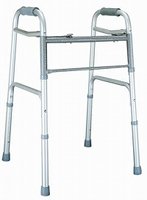
A folding walker is a basic standard walker with no wheels, folds in half for easy storage and transportation, is lightweight and sturdy.
It is most commonly used when a senior needs to keep weight off of their foot or leg (ie. after surgery or fracture).
Some elderly prefer to use these types of walkers in their home if they live in a very small apartment as a rollator can be too large. In theses cases, I recommend converting the walker into a front wheel walker as they do not have to pick it up every two steps. They can replace the front legs with wheels.
Some elderly use this type of walker for locations in the house where their regular walker (usually a rollator walker) cannot go. For example, elderly with small bathrooms may use a folding walker in the bathroom and a rollator walker in the rest of the house.
Elderly who live in multi-level homes may also have a folding walker on a floor of their home that they do not use very often and their other walker on the main floor.
Seniors should not be carrying their walker up/down stairs or risk not having a walker available on other levels of the home.
Who Should Use?
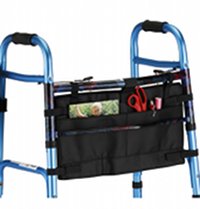
A folding walker with no wheels is usually only used for certain situations such as post surgery or fracture.
They are commonly used by seniors in the initial stages after a leg, hip or foot surgery or fracture as they can use it to keep weight off the area.
Some doctors may want their patients to put no weight, minimal weight (feather weight bearing), partial weight (slightly more weight), weight bearing as tolerated (as much as pain allows) and full weight bearing. They often want the senior to progress from less to more weight.
I have also recommended seniors use folding walkers when transferring from wheelchair to chair/bed/couch/car as they are sturdy and they only need something to hold onto for a few steps.
All other times, elderly would likely benefit from a different style of walker (such as a rollator walker).
Who Should NOT Use?
Seniors who do not need to keep weight off their foot/leg will be better off trying a different type of walkers for elderly.
Rollator walkers are much more enjoyable to use as they roll along (do not have to pick up) and have a seat and basket.
Folding walkers can be frustrating and slow to use as the senior has to pick it up every two steps.
Recommended Features
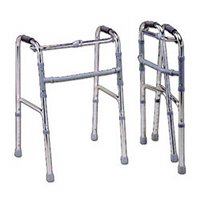
A well designed, high quality folding walker should have the following features:
- Height adjustable - This allows the user to adjust the walker to the right height and allows different people to use it.
- Level feet - Ensure that it has level feet. This means all the legs will rest on the ground at the same time on level ground.
- Lightweight - Since seniors have to pick it up every two steps, it's important it is lightweight (but strong).
- Easy to fold - Make sure it is be easy to fold - poorly designed models have small hard to push buttons and are stiff to fold.
- Comfortable handles - Have the senior try different handles as we all have different size hands.
Walker Accessories
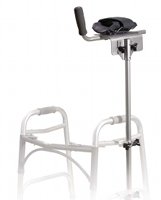
There are many different walker accessories for folding walkers, including:
- Bags - Are very handy as the senior's hands are busy using the walker
- Decorations - There are a number of flowers or other designs that can be attached to the walker to personalize it. This makes it look good as well as lets them identify it if there are many of them where they live.
- Trays - Not as useful as bags as it can be hard to keep the walker level
- Front wheels - Can be converted into a front wheel walker
- Skids/skis - These are placed on the rear wheels and in combination with front wheels, can be used to slide the walker instead of picking it up. However, this reduces it's stability and should only be used if the senior does not need to be concerned with non-weight bearing on a leg/foot.
- Forearm gutter attachments - These attach to the walker and allow the person to place weight on their forearm instead of their hands. This can be useful if they have severe arthritis or an arm/wrist/hand fracture.
How to Fit
As with other mobility products for the elderly, you want the height of the handle to be at the wrist of the senior.
How to measure for proper handle height:
- Have them wear their regular shoes
- Have the senior stand near a chair or wall for balance
- Have them stand tall and place an arm by their side
- Measure from the ground to the crease of their wrist
- Use this measurement while shopping/ordering a folding walker
How to Use
Basic technique for using a folding walker (once it's been properly fitted):
- Make sure walker is locked in open position
- Stand tall and hold onto the handles
- Pick up walker and move it in front of you - how far depends on how tall you are but start with small steps
- Walk into the walker with sore/injured/affected leg first
- Bring second foot into position beside first foot
- It should feel like walking within the walker
- A common problem is seniors putting the walker too far in front of them and hunching over
- Another common problem is getting too close to the front of the walker - try to keep the seniors heels behind the rear legs of the walker
How Much Do They Cost?
A folding walker costs $50-100.
Other Types of Walkers
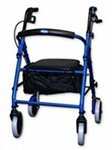
There are a variety of other walkers, including:
- Front wheel walker - Standard walker with two wheels and two legs/skis.
- Rollator walker - 4 wheels, bag/basket, seat and hand brakes.
- 3 wheel walkers - 3 wheels, bag/basket, no seat and hand brakes.
- Knee walker - Wheeled specialized walker for seniors with leg/foot surgery or fracture.
- U-Step walker - Specialized wheeled walker for elderly with neurological conditions such as Parkinson's Disease.
Return to Mobility Products for the Elderly
Return to Equipment for Seniors
Return to Caring for Aging Parents


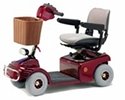



New! Comments
Have your say about what you just read! Leave me a comment in the box below.